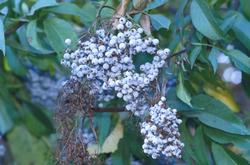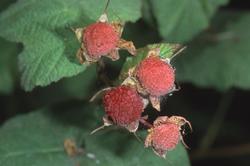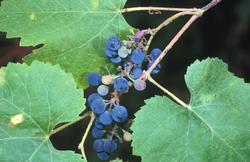Welcome edible native berries to your garden
-
Dot Zanotti Ingels
-
You can have it all when you welcome California native plants into your home garden. The Master Gardeners are always reminding you that native plants encourage habitat gardening, use less water, and don't need pesticides or much fertilization. I do not have much space in my garden, so I was happy to learn that some California native shrubs yield edible berries. So I can have a win/win of an attractive shrub and yummy berries.
Huckleberry (Vaccinium ovatum) is an evergreen shrub that grows 2-8 feet tall. They can grow in both sun and shade and prefer acidic soil. The leaves are leathery with bright glossy uppers and lighter green underneath. They are egg-shaped have finely serrated edges. It blooms small, bright pinkish, bell-shaped flowers. The flowers produce dark blue, small, shiny berries. Several native Indian tribes have eaten the berries raw, dried them, or used them in jams and jellies. Think of what you could make with yours? On top of your cereal, maybe?
Blue Elderberry (Sambucus mexicana) is a deciduous shrub that will become a small tree if it is not pruned. It has cream or yellow flowers in the spring and small dark blue to purple berries in the fall. It is tough and easy to grow. It adapts to available moisture levels and can tolerate full sun to partial shade. The berries can be eaten raw, but they shine in cooking or elderberry wine. Elderberry is easy to grow. Photo: UCANR
Elderberry is easy to grow. Photo: UCANRWild Strawberry (Fragaria vesca) is super easy to grow, and I tuck them around the garden. They look like a typical strawberry plant. The small fruits are conical in shape and sweet. These are great for tarts and jams or nibbling as you survey your garden.
Thimbleberry (Rubus parviflorus) are related to the blackberry, but they don't have the prickles on the stems. The thimbleberry bush is fast-growing deciduous, and attractive. The new shoots bear after 2-3 years. The green leaves are large, palmate, and finely hairy. The spring flowers are white and form in clusters of four to eight. When established, the shrubs require little maintenance but do appreciate regular moisture for good production—plant in part shade and well-draining soil. Thimbleberries were an important food source for the native tribes in the region who ate them fresh during the season and dried them to enjoy in the winter. It produces bright red, juicy fruits that pull from the plant, leaving behind the core. They are slightly tart and seedy but can be eaten right off the bush or made into jam. Thimbleberry are are relatives of the blackberry. Photo: UCANRCalifornia Wild Grape (Vitis californica) is a wild grape species that grows throughout central and northern California. It is a deciduous vine that is attractive all year long. In the spring, bright green leaves grow, followed by grey-green summer color. Autumn brings purple grape clusters hanging amidst the fiery fall foliage. As the vine becomes established, the twisted trunk and branches give us a winter show. The vine is gregarious and can grow to 30 feet and ramble over and above anything its tendrils can grasp. Pruning will keep it in line. It prefers full sun on its leaves. When the fall leaves drop, they are perfect for the compost pile. It usually grows near river and creek beds where they can get moisture most of the year, but they can be pretty drought tolerant when established. The grapes are yummy, but they do have seeds. They can be added to a smoothie or made into juice, jam, and jellies.
Thimbleberry are are relatives of the blackberry. Photo: UCANRCalifornia Wild Grape (Vitis californica) is a wild grape species that grows throughout central and northern California. It is a deciduous vine that is attractive all year long. In the spring, bright green leaves grow, followed by grey-green summer color. Autumn brings purple grape clusters hanging amidst the fiery fall foliage. As the vine becomes established, the twisted trunk and branches give us a winter show. The vine is gregarious and can grow to 30 feet and ramble over and above anything its tendrils can grasp. Pruning will keep it in line. It prefers full sun on its leaves. When the fall leaves drop, they are perfect for the compost pile. It usually grows near river and creek beds where they can get moisture most of the year, but they can be pretty drought tolerant when established. The grapes are yummy, but they do have seeds. They can be added to a smoothie or made into juice, jam, and jellies. California wild grape is a deciduous vine that is attractive year round. Photo: UCANR
California wild grape is a deciduous vine that is attractive year round. Photo: UCANRTry something new and native this year.



